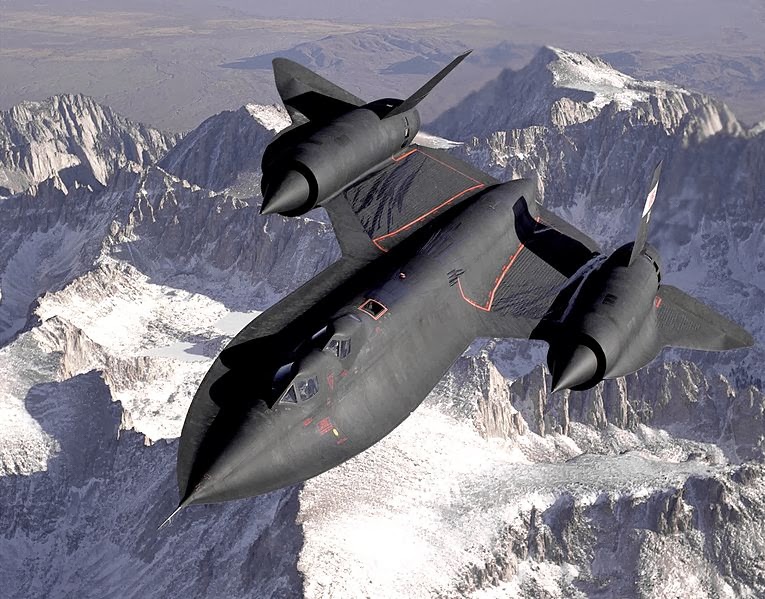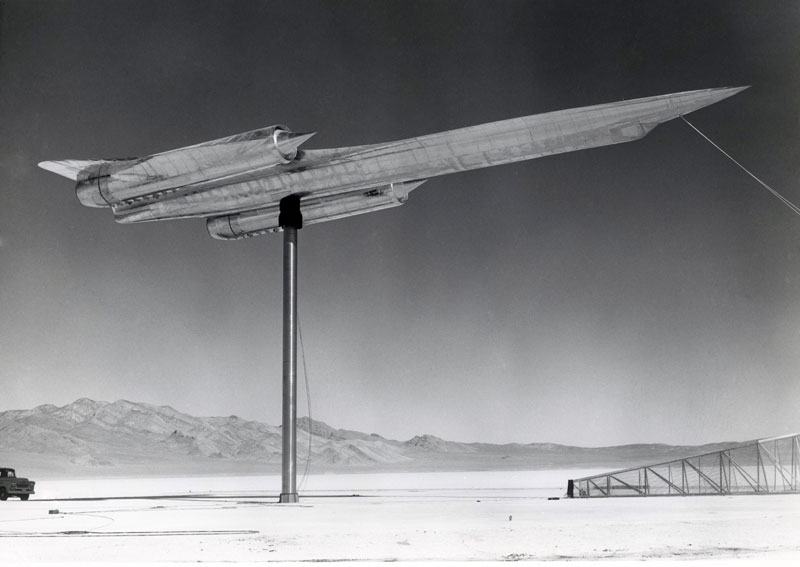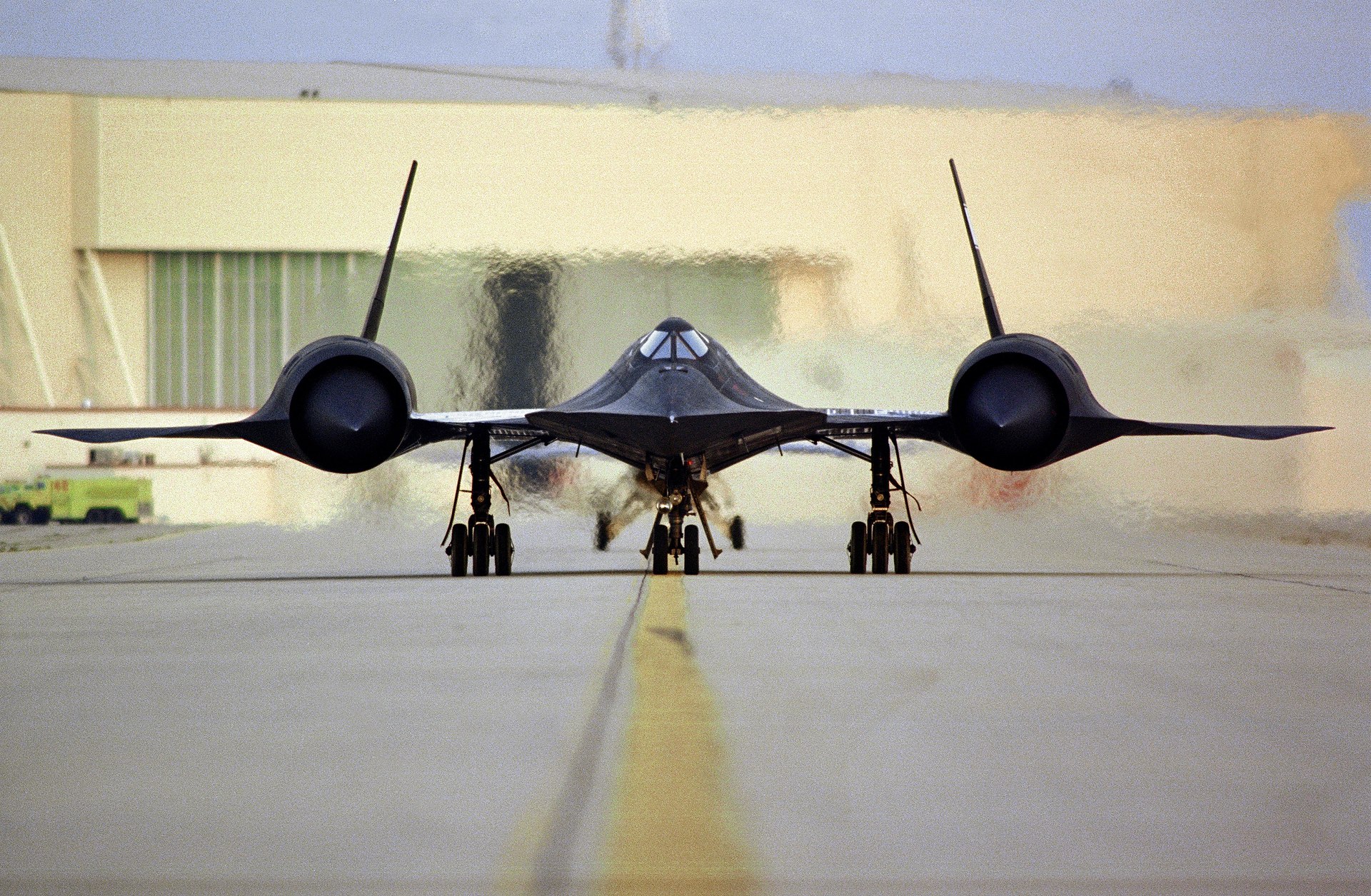
The SR-71B Blackbird, flown by the Dryden Flight Research Center as NASA 831
slices across the snow-covered southern Sierra Nevada Mountains of California
On December 22, 1964, the Lockheed SR-71 Blackbird Mach 3+ strategic reconnaissance aircraft started for her maidenflight. Since 1976, it holds the world record for the fastest air-breathing manned aircraft.
Predecessors
The SR-71’s predecessor was the reconnaissance aircraft Lockheed U-2. But it was known to be very slow and was mostly used by CIA. Shortly after the introduction of the U-2, the CIA began to have serious doubts about its ability to fly over Soviet territory without damage. Therefore, the Lockheed and Convair companies were contacted in early 1958 and asked for a concept for a high-flying high-speed reconnaissance aircraft. Lockheed already had experience in building high-flying spy planes with the U-2, while Convair had already built the supersonic bomber B-58 Hustler. Other companies also participated. In addition to the designs by Lockheed and Convair, a proposal by Boeing and an own design by the United States Navy were reviewed in September 1958. In the end, however, only Lockheed and Convair were successful. As a result, both manufacturers improved their design once again, Convair designed the self-launching Convair Kingfish, Lockheed the A-12. The two aircraft were submitted to a commission of representatives of the Ministry of Defence, Air Force and CIA on 20 August 1959. While Lockheed’s design had slightly better performance and lower costs, Kingfish’s stealth technology was better. In the end Lockheed was chosen because the U-2 had been delivered on time and within budget, but Convair had failed to deliver the B-58. With the Skunk Works, Lockheed also had the experience and infrastructure to deal with secret projects, and with Clarence “Kelly” Johnson, an experienced chief designer.[4]

A-12 measuring the radar reflection (radar cross section) at Groom Lake
Titanium
The delivery date for the first machine was set for August 1, 1961. However, as there were problems both with the delivery of the required titanium and with the completion of the engines, this date could not be met. Until 1961, Titanium Metals Corporation, as the supplier of the material, had problems in supplying sufficient titanium in sufficient quality, so that up to 80% of the material had to be rejected beforehand. But even after that, there were difficulties in production. Because of the high hardness of titanium, Lockheed had to abandon assembly line production and develop new tools for production. The delivery date for the first machine was set for August 1, 1961. However, as there were problems both with the delivery of the required titanium and with the completion of the engines, this date could not be met. Until 1961, Titanium Metals Corporation, as the supplier of the material, had problems in supplying sufficient titanium in sufficient quality, so that up to 80% of the material had to be rejected beforehand. But even after that, there were difficulties in production. Because of the high hardness of titanium, Lockheed had to abandon assembly line production and develop new tools for production.
Keeping a Secret
The main problem in the development of the A-12 was the extremely high temperatures that the high speed involved. Parts of the aircraft’s outer skin heated up to about 480 °C (900 °F) at Mach 3. All components had to be adapted to these high temperatures. Lockheed also needed lubricants and high-temperature hydraulic fluids for the A-12, which ultimately led to the development of synthetic alternatives. After a short, unofficial flight of only a few kilometres on 25 April 1962, the maiden flight took place on 26 April. On May 2, the sound barrier was broken for the first time. Since the test flights were to remain secret, the CIA and Air Force instructed all regional offices of the Federal Aviation Administration and the North American Aerospace Defense Command as early as 1962 to report radar contacts with unidentified, fast-moving and high-altitude objects only in writing and under no circumstances to mention them by radio. In 1967 and 1968 the A-12 flew 29 missions over Vietnam and Korea, then they were decommissioned in favor of the Blackbirds. Of the 13 planes built, five crashed, and eight are now on display in museums.
Lockheed SR-71 Blackbird
The SR-71 was designed for flight at speeds beyond Mach 3 with a flight crew of two in tandem cockpits and to minimize its radar cross-section. As a special feature, titanium was used on 85% of the Blackbird. This was special, because most aircraft were equipped with the minimum amount of titanium due to the high costs. Also, the aircraft was equipped with several features to reduce its radar signature, but engineers later conceded that the Soviet radar technology advanced faster than the stealth technology employed against it. The sharp edges on either side of the aircraft generated powerful vortices and additional lift, which significantly improved the aerodynamic performance and stability. The SR-71 could be refueled in air by special tankers on longer missions, and refueling even worked at the tanker’s maximum airspeed. The incredible speed that came with the aircraft and its new operational service ceiling of more than 20km, new oxygen masks had to be created to provide more oxygen as well as a heavy-duty cooling system.

Lockheed SR-71, On runway, engines on
Innovative Design
What made the SR-71 so innovative were her engines, two Pratt & Whitney J58-P4, which could produce a static thrust of 145 kN. A unique hybrid, the engine can be thought of as a turbojet inside a ramjet. At lower speeds, the turbojet provided most of the compression and most of the energy from fuel combustion. At higher speeds, the turbojet largely ceased to provide thrust; instead, air was compressed by the shock cones and fuel burned in the afterburner. A side effect was that as the ramjet engines approached their maximum speed, fuel consumption per distance decreased as the efficiency of the ramjet increased. These hybrid engines require very complex control mechanisms, which drove up development costs. During its maiden flight on December 22, 1964, the SR-71 reached a top speed of Mach 3.4 and the very first aircraft to enter service was delivered to California in 1966. In 1968, the first operating location was reached in Okinawa, where the nickname Habu (a Japanese snake) was created for the aircraft. Unlike its Soviet counterpart, the MiG-25 (3-8 min Mach 2.83) the SR-71 could maintain its top speed over long distances. The pilot wore a suit very similar to those used in space travel (model David Clark S-1030) and was ventilated with pure oxygen. The reconnaissance sensors were able to cover an area of 259,000 km² per flying hour. Most of the titanium needed for the construction had to be procured from the Soviet Union.
Records and Retirement
During the years, a total of 32 planes were built and the SR-71 finally retired in 1998, because the main task (reconnaissance by photographs) could be carried out more safely with spy satellites, according to official statements at that time. The SR-71 was the world’s fastest and highest-flying operational manned aircraft throughout its career. The New York City – London distance was flown in only 1 hour 54 minutes, which was an hour faster than the fastest commercial Concorde flight. The Boeing 747 would take about 6 hours and 15 minutes for the same distance. The altitude record of jet aircraft in horizontal flight of 25,929 m (the absolute altitude record of 37,650 m was achieved by a MiG-25 in parabolic flight), and the speed record of 3529.6 km/h was set by an SR-71A. The fastest USA crossing (about 4000 km) was made by a NASA machine in 1990: It took 68 min 17 s, which corresponds to a cruising speed of 3500.7 km/h. The SR-71 finally was permanently retired in 1998. All remaining aircrafts are on display in museums today, except two which remain at NASA.
Javier Urzay, ME356 Hypersonics Lecture 1: Introduction [Remastered 2021], [7]
References and Further Reading:
- [1] SR-71 Blackbird photographs and videos at NASA’s Dryden Flight Research Center’s web site
- [2] The Online Blackbird Museum
- [3] The SR-71 Pilot Full Pressure Suit
- [4] The Beautiful Aircraft Designs of Kelly Johnson, SciHi Blog
- [5] CIA-Dokument The U-2’s Intended Successor:Project Oxcart,1956-1968.
- [6] Lockheed SR-71 at Wikidata
- [7] Javier Urzay, ME356 Hypersonics Lecture 1: Introduction [Remastered 2021], Stanford, Spring 2021, Javier Urzay @ youtube
- [8] Timeline of aircrafts designed by Kelly Johnson, via Wikidata






Pingback: Whewell’s Gazete: Year2, Vol. #24 | Whewell's Ghost
Ben Rich wrote about this aircraft in his book “Skunk Works”.
https://en.wikipedia.org/wiki/Ben_Rich